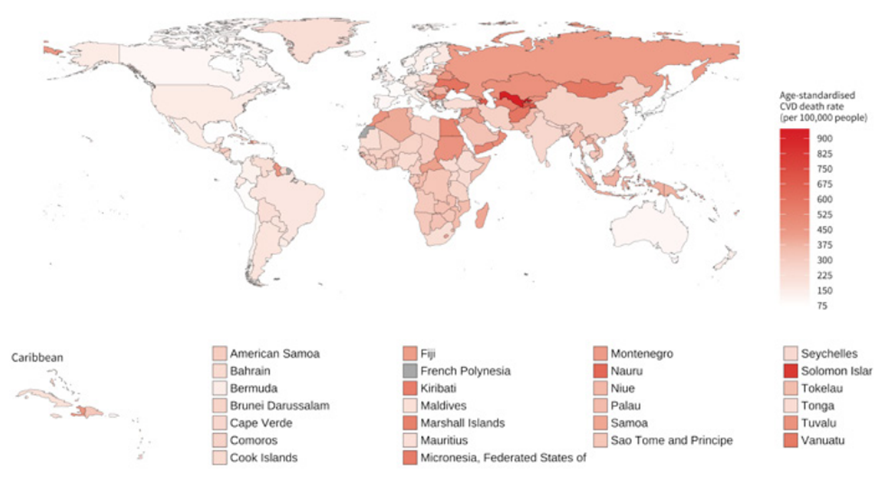Health and Tech Institute
strategy for continuous transformation
Joaquim Cardoso MSc
Health and Tech Institute
strategy for continuous transformation
Joaquim Cardoso MSc
Chief Research and Strategy Officer (CRSO),
Editor in Chief and Senior Advisor
June 2, 2023
EXCERPT:
CVDs are the leading cause of mortality and a major contributor to disability.
- Globally, the estimated number of deaths due to CVDs increased from around 12.1 million in 1990 (equally distributed between males and females)
- to 18.6 million (9.6 million males and 8.9 million females) in 2019 (Figure 1).
Figure 1: Global trends in number of deaths due to cardiovascular diseases, 1990–2019.
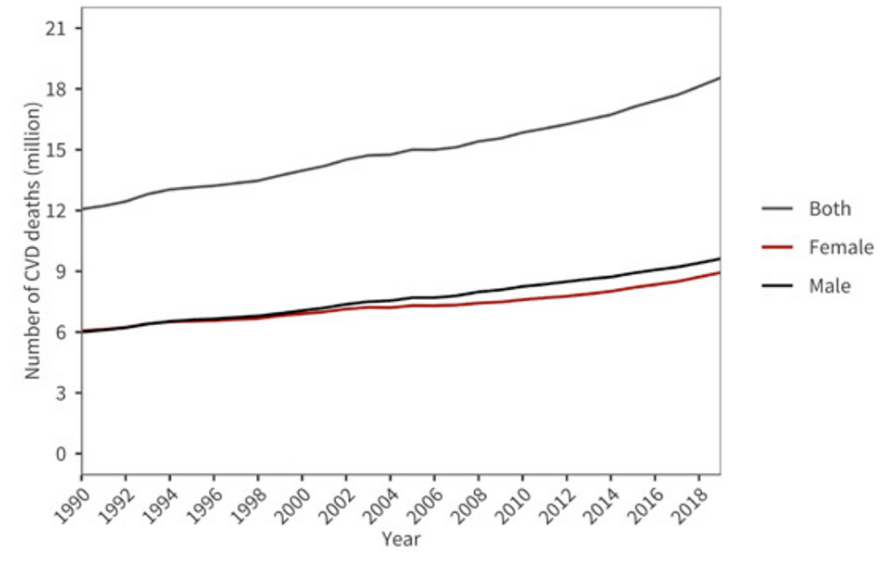
Source: Institute for Health Metrics and Evaluation (IHME). GBD Compare Data Visualization. Seattle, WA: IHME, University of Washington, 2020. Available from http:// vizhub.healthdata.org/gbdcompare. (18 March 2023).
The number of deaths due to CVDs in 2019 represented 33% of all global deaths,
- with ischaemic heart disease (9.1 million deaths) and
- stroke (6.6 million deaths) totalling 85% of all CVD deaths worldwide.
While the number of deaths due to CVDs over the last 30 years has increased globally — in large part due to an ageing and growing population — the age-standardised death rate has declined by one third,
- from 354.5 deaths per 100,000 people in 1990
- to 239.9 deaths per 100,000 people in 2019 (Figure 2).
Figure 2: Global trends in age-standardised cardiovascular disease death rate (per 100,000 people), 1990–2019.
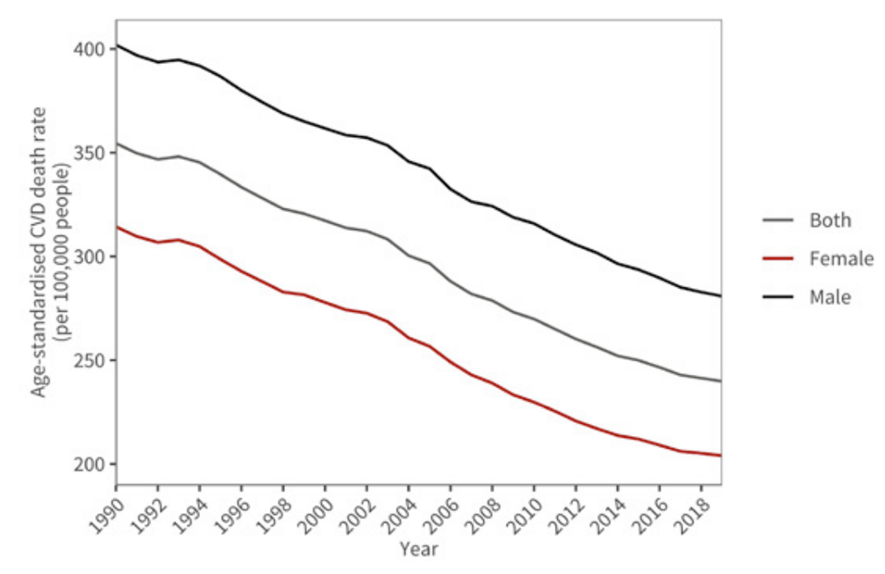
Source: Institute for Health Metrics and Evaluation (IHME). GBD Compare Data Visualization. Seattle, WA: IHME, University of Washington, 2020. Available from http://vizhub.healthdata.org/gbd-compare. (18 March 2023).
Age-standardization is a technique used to better compare disease outcomes, such as death rates, across populations.
It calculates what the disease outcome would be if the population age-structure were the same for all countries. This allows an assessment of whether the observed differences are due to factors related to the disease, rather than the age structure of the population.
CVD death rates declined across all regions in this period, though the decline has been slowing in the past decade and is uneven across regions (Figure 3).
- The High-Income region, for example, experienced the fastest average rate of decline for both males and females from 1990 to 2019 (average annual rate of change of 2.6%).
- The slowest rate of decline in both sexes was observed in the Southeast Asia, the South Asia, East Asia and Oceania, and the SubSaharan Africa regions.
- Almost no improvement in CVD death rate for males was observed in these regions.
- Underscoring the disparities in progress, the death rate in the Sub-Saharan African region was 1.2 times higher than the High-Income region in 1990,
- whereas by 2019 the gap had grown to a death rate 2.1 times higher in Sub-Saharan Africa than in the High-Income region.
The High-Income region had the lowest CVD death rate overall (102.1 and 153.8 deaths per 100,000 people for females and males respectively).
Only the Latin America and the Caribbean region achieved a decline in female death rates in 2019 that reached the rate the High-Income region had registered in 1990.
- For males, in 1990 the lowest levels of CVD death rate were recorded in Latin America and the Caribbean, Sub-Saharan Africa,
- and High-Income regions with South Asia only achieving a decline in 2019 that reached those levels.
The Central Europe, Eastern Europe and Central Asia region had the highest age-standardized CVD death rates for males and females in both
- 1990 (670.2 and 467.2 deaths per 100,000 people respectively) and
- 2019 (524.1 and 345.7 deaths per 100,000 people respectively).
The North Africa and Middle East region had the second highest rates for males and females in 2019 (376.7 and 339.8 deaths per 100,000 people for males and females respectively).
Figure 3 — Regional trends in age-standardised cardiovascular disease death rate (per 100,000 people), 1990–2019. National age-standardised CVD death rates are shown in Figure 4.
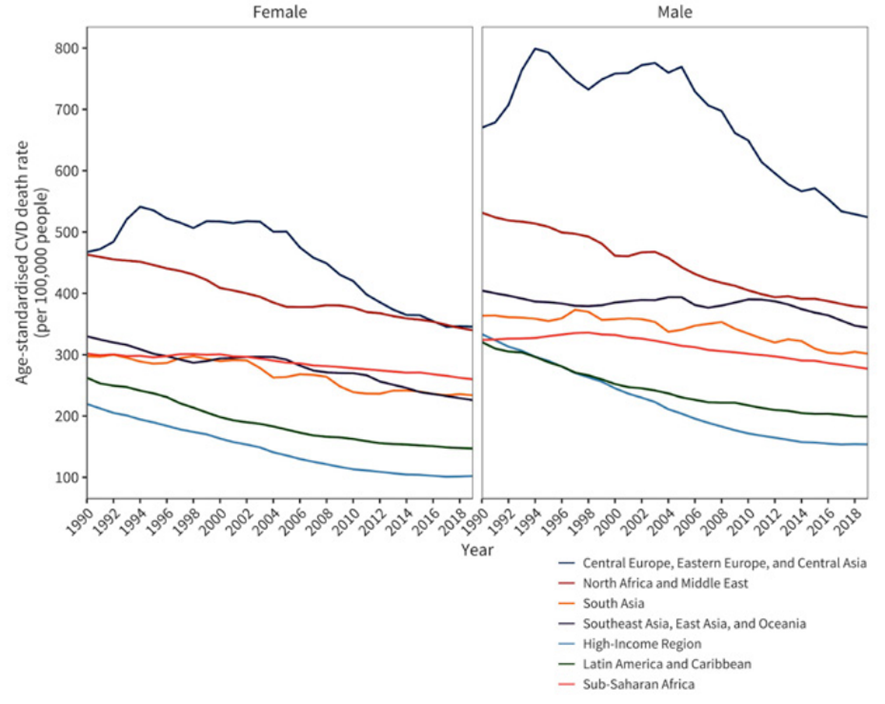
Source: Institute for Health Metrics and Evaluation (IHME). GBD Compare Data Visualization. Seattle, WA: IHME, University of Washington, 2020. Available from http://vizhub. healthdata.org/gbd-compare. (18 March 2023)
Figure 4: National age-standardised cardiovascular disease death rate (per 100,000 people, both sexes), 2019. Countries and territories without data are shown in grey
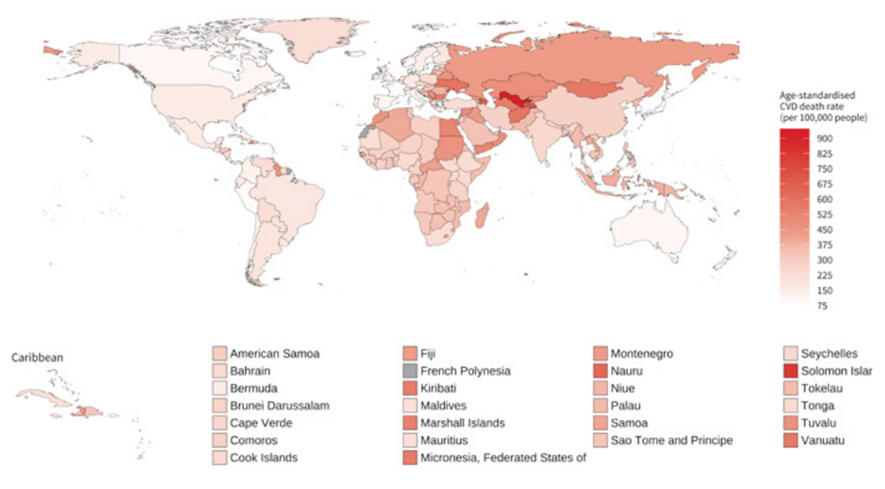
Source: Institute for Health Metrics and Evaluation (IHME). GBD Compare Data Visualization. Seattle, WA: IHME, University of Washington, 2020. Available from http://vizhub.healthdata.org/gbd-compare. (18 March 2023).
Original Publication:
Full version
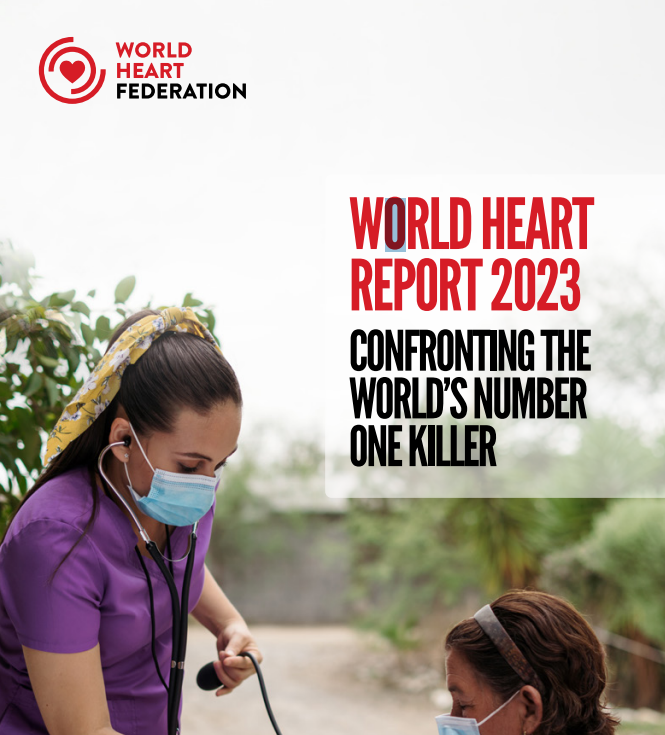
World heart report 2023 — Confronting the world’s number one killer
World Heart Federation (WHF).
Mariachiara Di Cesare, Honor Bixby, Thomas Gaziano, Lisa Hadeed, Chodziwadziwa Kabudula, Diana Vaca McGhie, Jeremiah Mwangi, Borjana Pervan, Pablo Perel, Daniel Piñeiro, Sean Taylor, Fausto Pinto.
Reviewers: Victor Aboyans, Álvaro Avezum, Rick Chazal, Jean-Luc Eiselé, Naomi Herz, Andre Pascal Kengne, Angela Koh, Amam Mbakwem, Jagat Narula, Gregory Roth, Saate Shakil.
Editor: Edward Fox.
The World Heart Report 2023 was made possible through support from Novartis Foundation.




